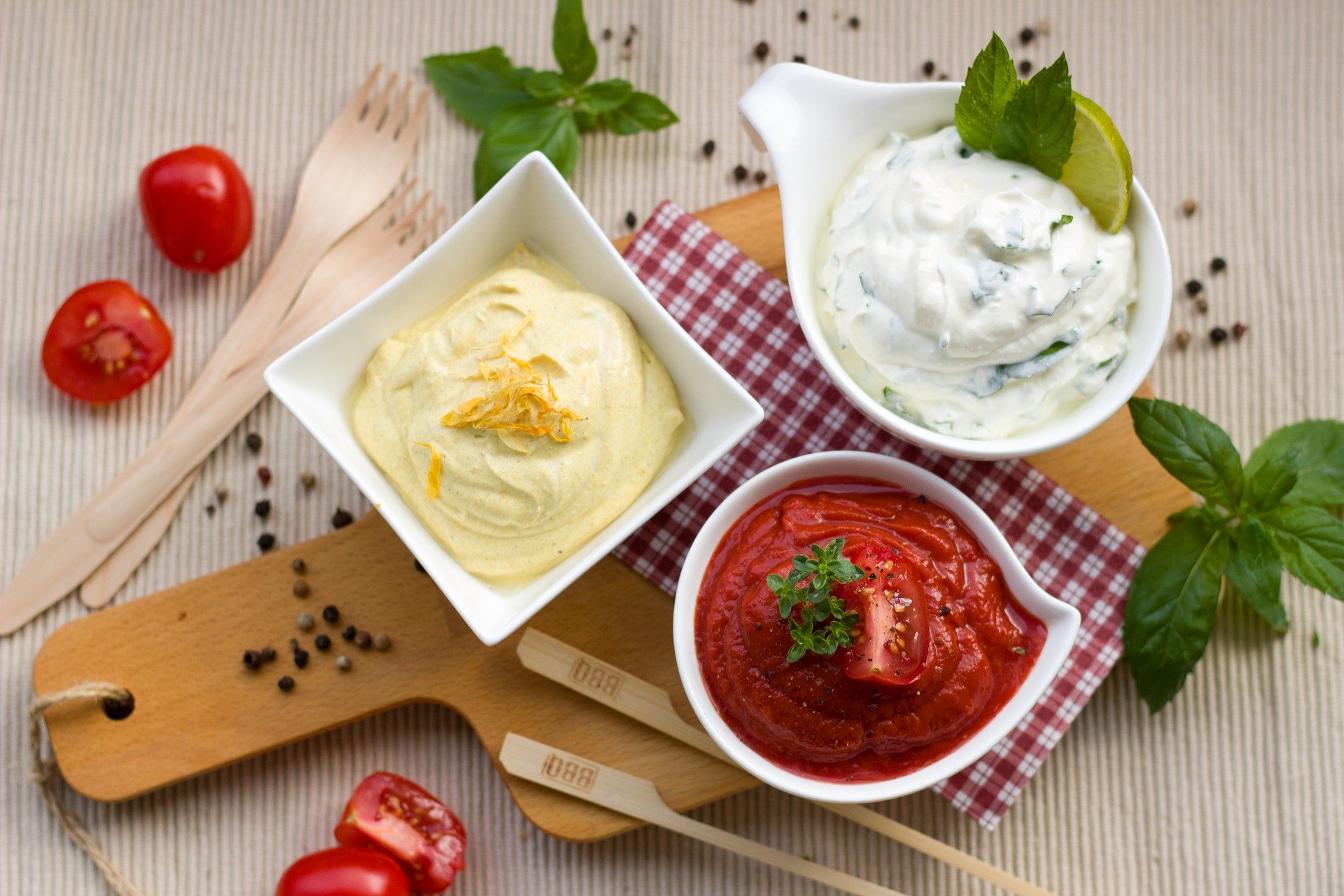
Sweet & Saucy! A Comprehensive Collection Of Condiments
Sweet & Saucy! A Comprehensive Collection Of Condiments
Whether it’s drizzling mint sauce over a perfectly cooked leg of lamb, or dipping your triple-cooked chips in a dollop of ketchup, there is no denying that the simple condiment is a staple of the dinner table.
But why?
Would it surprise you to know that there is a scientific reason why we enjoy specific accompaniments with particular foods?
The Science!
Your tongue has between 2000 and 4000 taste buds; sensory organs that allow you to experience the 5 universally accepted, basic tastes – sweet, salty, sour, bitter and umami.
The first four are self-explanatory, but the fifth, umami translates as ‘savouriness’ and is best described as the savoury taste of meats and broths. Umami was first recognised in 1990, but not discovered until 2006.
The Sauces!
Ketchup
We start our list with what is the most popular condiment globally, and one that scientists have declared ‘the perfect food’.
A European variant of the Asian ‘ke tsiap’, it was originally used as a fish sauce, and adapted by the British around 1730.
However, the original British version was far from the instantly recognisable tomato sauce we know today. Early recipes included ingredients such as mushrooms, oysters, walnuts, and anchovies, trying to reproduce the savoury tastes found in Asia.
Fast forward to 1812, and the union of ketchup to the humble tomato, and thus, a legend was born!
Many condiments can excite one or even two of the taste buds, but ketchup, in its current form, is one of the only foods that can cater to all five!
It is for this reason then, that scientists have given ketchup the title of ‘the perfect food’.

Mayonnaise
It was a Frenchman, the chef of Duke de Richelieu, who invented mayonnaise in 1756. When France defeated the British at Port Mahon, the chef wanted his victory feast to include a sauce made of cream and eggs.
Finding a distinct lack of cream, he improvised using oil instead, and voila! Mayonnaise was born.
Mayonnaise has a strange history. During the great depression of the late 1920s and early 1930s, to say there was a lack of food would be an understatement. But adding mayonnaise to recipes meant that food could go further.
The 70s was the era of ‘The Dinner Party’. With food shortages a thing of the past, creating show-stopping dishes to impress your guests was the new norm – and mayonnaise and gelatin were the dynamic duo that featured in most table-top delights.
Nowadays, mayonnaise forms the basis for many other condiments rather than being a recipe staple in itself… luckily for us!
Brown Sauce
In 1895, Frederick Gibson Garton, a grocer from Nottingham developed what we now know as H.P. Sauce – king of the brown sauce varieties.
After discovering that a restaurant in the Houses of Parliament was serving his brand, he registered the name H.P. Sauce. (which is why bottles of HP have the Houses of Parliament on them!)
In 1903, the recipe and brand were sold to E.S. Moore, who launched a nationwide marketing campaign, including hiring door-to-door salesmen to sell miniature bottles.
Around this time, the ingredients to make chutneys were expensive, but this spicy accompaniment offered the same taste for a fraction of the price.
In the 60s, H.P. Sauce became known as ‘Wilson’s Gravy’, following an interview with the wife of Prime Minister Harold Wilson, in which she stated that:
“If Harold has a fault, it is that he will drown everything with H.P. Sauce”
Mint Sauce
There are many theories why we use mint sauce to accompany a roast lamb.
Some stem from the fact that mutton was once preferred over the more tender lamb we have today.
Mutton itself can be tough and fatty. Pairing it with a combination of mint, vinegar, and sugar makes it more palatable and easier to digest.
A different theory describes how Queen Elizabeth I decreed that lamb and mutton could only be eaten with mint sauce, as a way to slow down the consumption of these animals in order to protect the wool trade.
But scientifically speaking, lamb and mint sauce were always meant to be together.
Lamb has a distinct flavour, unlike any other meat. This is because whilst it is cooking it releases specific compounds found in the fat – branched-chain fatty acids (BCFAs).
Mint is full of branched-chain ketones, which are chemically related to the BCFAs found in lamb. This pairing means that lamb and mint sauce are chemically (and delectably) made for each other!
Horseradish
Horseradish has a long history and has been used for many different things – from a cure for back pain, a treatment for rheumatism, and even an aphrodisiac.
Found in hedgerows and country lanes during times gone by, inns and coach stations would use horseradish to make a cordial that would revive sleepy travellers.
We now associate horseradish as a spicy accompaniment for beef. Belonging to the same family as mustard, the compounds in horseradish allow us to break down the fattier cuts of beef, meaning we can enjoy the rich taste whilst still being able to digest it!

Bread Sauce
‘The idea of bread sauce remains intensely baffling, possibly even disgusting, to any person who hasn’t been brought up with British traditions’ – Nigella Lawson
Just like the quintessential British-ness of the Yorkshire pudding, bread sauce is lost on anyone outside the UK.
Bread sauce has been traced back as far as medieval times, when cooks used up their stale bread to thicken sauces.
When bread was changed to a flour-based roux, and industrial sliced bread was readily available, using bread to thicken sauces became a thing of the past.
But bread sauce has survived, perhaps because of its simplicity to make, and perhaps because Brits are a stickler for tradition!
Cranberry Sauce
Along with bread sauce, cranberry is a must-have of any Christmas dinner.
But why is it that this festive condiment is rarely used outside of December?
The origins of cranberry sauce come from the American’s first Thanksgiving. The Wampanoag tribe had been using them for food, dye, and medicine for years before the first pilgrims arrived in the US.
Whether cranberries were served at that first meal is unknown, but soon after, they became part of American culture as a staple for every Thanksgiving dinner.
For many centuries in the UK, Christmas dinner was centred around roast goose. But when Charles Dickens wrote about Ebenezer Scrooge replacing Bob Cratchit’s ‘poor’ goose, with a more expensive turkey, readers followed suit.
Turkeys were imported to the UK from America, and along with the bird came the tradition of cranberry sauce. Now, Christmas wouldn’t be the same without it!
Whatever your personal preferences, we hope this list has given you a good insight into the history behind some of our favourite saucy side dishes!
Article by Caterquip


